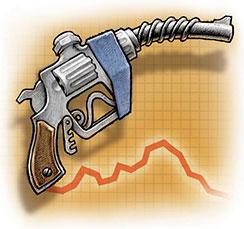Amherst Economist Links Clean Air Act to Drop in Violent Crime
This 2008 Amherst magazine article reported on research by Jessica Wolpaw Reyes '94. In the years since the article appeared, Reyes, now Professor of Economics, has continued to study the relationship between lead levels and crime rates.
By Emily Gold Boutilier
 |
The Clean Air Act began as environmental policy. Now, an Amherst economist links it to a large and surprising drop in violent crime.
In a paper published in October in the B.E. Journal of Economic Analysis & Policy, Jessica Wolpaw Reyes ’94, assistant professor of economics, credits the law’s removal of lead from gasoline in the 1970s with a more than 50 percent decline in violent crime in the 1990s.
Anyone who follows news about lead in children’s toys already knows that lead can affect neurological development: various studies link childhood lead exposure to IQ changes, to attention deficit disorder and to aggressive behavior. In addition, medical studies show violent criminals to have higher levels of lead in their bodies than others do.
In 1973, car fumes were the source of most of the lead in the air, dust and dirt in U.S. urban areas. The following year, under the Clean Air Act, the Environmental Protection Agency set a timetable to phase out leaded gas. As a result, average lead levels in children plummeted in the late 1970s and early 1980s.
Meanwhile, violent crime in the United States increased 83 percent from 1972 to 1992, but then began to fall sharply. Various studies have pointed to possible causes, including economic growth and an increase in police officers, but Reyes, who has worried about lead paint ever since she became a mother, decided to look at lead as another factor. She knew that crime rates fell just as children of the late 1970s and early 1980s reached the age at which they were most likely to commit violent crimes. But that data wasn’t enough.
At the start of her study, Reyes knew she’d need to compare people exposed to higher lead levels with those exposed to lower ones in a given year. Fortunately for her, the Clean Air Act allowed states to phase out leaded gas on different schedules. Reyes did an intricate 50-state comparison. As The New York Times Magazine explained in an Oct. 21, 2007, article about her study, Reyes concluded that if other possible causes of crime, like unemployment, had stayed the same, switching to unleaded would have caused a 56 percent drop in the per capita violent crime rate in the 1990s. This led the Times writer, Jascha Hoffman, to ask, “Has the Clean Air Act done more to fight crime than any other policy in American history?”
Freakonomics author Steven D. Levitt, who has a blog on the New York Times Web site, wrote in July that Reyes “has put together what appears to me to be the most persuasive evidence to date in favor of a relationship between lead and crime.”
Reyes, who continues to research the connection, predicts continuing declines in crime in the future. What’s more, she says her study shows that environmental policy can have unintended consequences. “The idea that we could change who the population is—on a large scale—and not even notice it is really striking,” says the professor, who’s teaching a course this semester on evaluating social policy.
Image by Phil Foster.